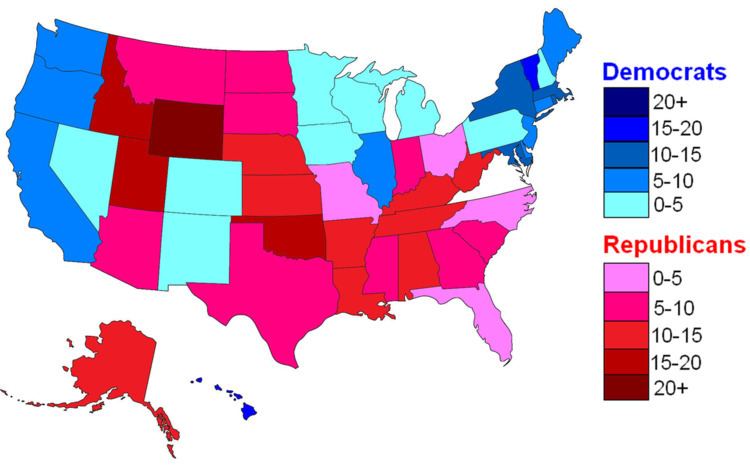 | ||
The Cook Partisan Voting Index, also called PVI, is a measurement of how strongly a United States congressional district or state leans toward the Democratic or Republican Party, compared to the nation as a whole. The Cook Political Report introduced the PVI in August 1997 to better gauge the competitiveness of each district using the 1992 and 1996 presidential elections as a baseline. The index is based on analysis by the Center for Voting and Democracy (now FairVote) for its July 1997 Monopoly Politics report.
Contents
Calculation
PVIs are calculated by comparing the district's average Democratic or Republican Party's share of the two-party presidential vote in the past two presidential elections to the nation's average share of the same. The national average for 2004 and 2008 was 51.2% Democratic to 48.8% Republican. For example, in Alaska's at-large congressional district, the Republican candidate won 63% and 61% of the two-party share in the 2004 and 2008 presidential elections, respectively. Comparing the average of these two results (62%) against the average national share (49%), this district has voted 13 percentage points more Republican than the country as a whole, or R+13.
Prior to its April 2009 update, the PVI formula was calculated by comparing district-level results for the past two presidential elections to nationwide results for the most recent election. David Nir of the Swing State Project advocated a change to the new formula, and Charlie Cook agreed, wanting an "apples to apples" comparison.
Format
The Cook PVI is formatted as a letter, plus sign, and number:
For districts without a lean, the index written as "EVEN" without a number.
Extremes and trends
The most Democratic congressional district in the country is New York's 15th, located in the Bronx, with a PVI of D+43. The most Republican district is Texas's 13th at R+32. As for states as a whole, Wyoming and Utah are the most Republican at R+22, and Hawaii is the most Democratic at D+20.
The most Democratic congressional districts to be represented by a Republican are Iowa's 1st and New York's 24th with a PVI of D+5. Iowa's 1st is represented by Rod Blum and New York's 24th is represented by John Katko. The most Republican congressional district to be represented by a Democrat is Minnesota's 7th and it is represented by Collin Peterson. In total there are nine Democratic-leaning House districts represented by Republicans following the 2014 elections (up from five from before the election) and eight Republican-leaning House districts represented by Democrats (down from 15 before the election). This represents a total of 17 out of 435 Representatives from districts with a PVI opposite to their own party.
In the Senate, the most Republican-leaning state to have a Democratic senator is West Virginia, with Democrat Joe Manchin. The least Democratic-leaning state to have two Democratic senators is Virginia, represented by Mark Warner and Tim Kaine, with no Republican-leaning states at all having elected two Democrats as of the 2014 elections. The most Democratic-leaning state to have a Republican senator is Maine with Republican Susan Collins. The most Democratic-leaning state to have two Republican senators is Iowa, represented by Chuck Grassley and Joni Ernst.
Four Republican-leaning states (the most Republican being West Virginia at R+13) have governors from the Democratic Party while twelve Democratic-leaning states (the most Democratic being Vermont at D+16) have governors from the Republican Party.
All Republican-leaning states have a majority Republican house delegation, as well as six Democratic-leaning states and neutral Virginia. The most Democratic-leaning state to have a majority Republican house delegation is Michigan at D+4, while the least Democratic-leaning state to have a majority Democratic delegation is New Hampshire at D+1. Massachusetts has the largest number of Representatives (nine) of the six states that have entirely Democratic delegations; Oklahoma has the largest number of Representatives (five) of the eleven states that have entirely Republican delegations. Note that the seven states with only one representative must be among these; two are Democratic (Delaware and Vermont) and five are Republican (Wyoming, South Dakota, North Dakota, Montana, and Alaska).
